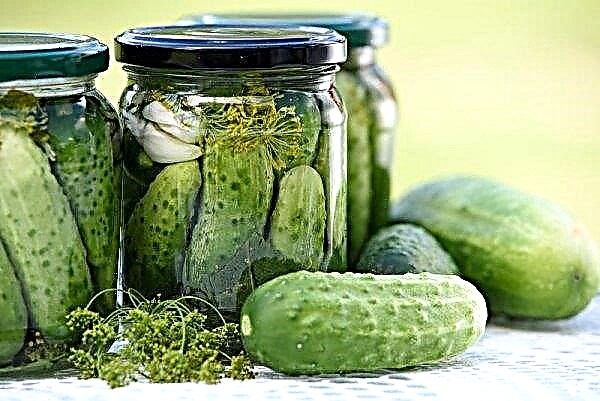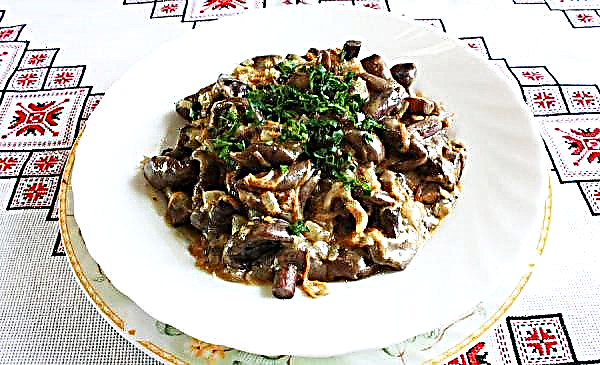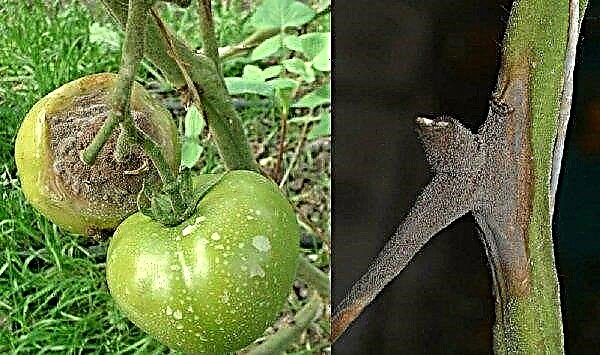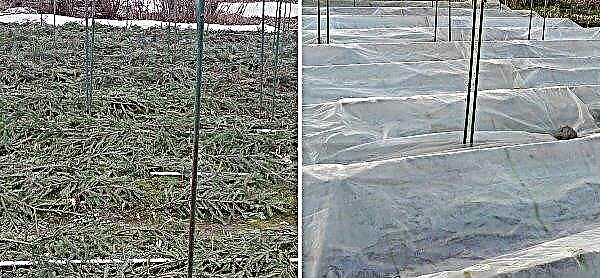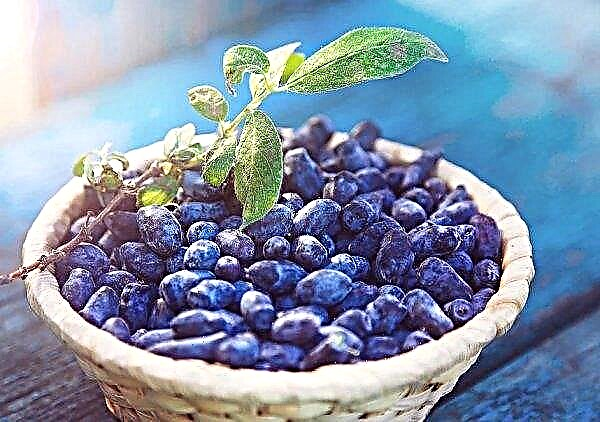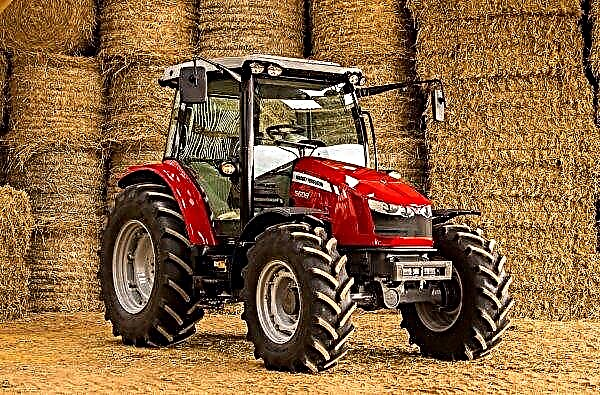Tomato Golden Heart refers to fruit crops intended for cultivation in any conditions. This plant, regardless of climate, gives good yields, characterized by excellent quality. In addition, this tomato is an ideal dietary product for adults and children. In the article we will consider in detail the features of the variety, and also list the main rules for its cultivation.
Grade description
Tomatoes Golden Heart are considered one of the best assets of the Russian selection school. This plant was bred in the late 1990s. within the walls of the Research Center for Seed Breeding and Agricultural Engineering, breeder Yuri Pancev. The scientist managed to get not only bright and saturated fruits, but also achieve their highest production quality.
Variety characteristic:Did you know? The first tomatoes began to be cultivated by the ancient Aztecs. In addition to food purposes, the Indians used the fruits of the culture as a universal medicinal plant to combat ailments and infections.
- refers to early ripe crops, the first fruits are ready for harvesting already 90-95 days after transplanting;
- bushes are determinant, do not exceed 80-120 cm in height;
- universal type culture, designed for growing in greenhouses and in open ground;
- elegant plant, with a moderately thin stem and small leaves, saturated green tint;
- in greenhouse conditions the bushes are more tall, in natural compact;
- fruits of medium size, oval or heart-shaped. Ribbed inclusions distinctly appear near the peduncle, and on the edge there is a slight pointedness;
- saturated orange fruits with a thin, glossy skin;
- the average weight of one ripe tomato is 120-200 g;
- the pulp is juicy and fleshy, it is characterized by numerous seeds;
- crop yield from 1 square. m is 6-7 kg;
- 5-7 tomatoes ripen in one flower brush;
- high transportable crop quality, able to be stored for a long time;
- tomatoes are suitable for cooking and preparing fresh salads;
- the taste of tomatoes is saturated, moderately watery.

Advantages and disadvantages
- The main advantages of Golden Heart tomatoes:
- ripe fruits are perfectly stored without special conditions;
- small height of the bush;
- give an ovary regardless of weather conditions;
- suitable for conservation;
- in the greenhouse bear fruit until late autumn;
- propagated from the seeds of the fruit.
- The main disadvantages of the variety:
- sensitive to watering and soil conditions;
- fresh tomatoes taste excessive acidity;
- bushes need to be planted, otherwise productivity decreases.
Growing Features
Tomatoes Golden heart to grow in the country is not difficult. You can get fruits in any climatic conditions. To do this, ensure that the tomatoes have the right microclimate and water regime. And also carry out preparatory work.
Conditions
The variety belongs to the heat-loving and photophilous culture. Better plants develop at a day temperature of +22 ... + 25 ° С and at night no lower than +16 ... + 18 ° С. The seeds of the culture are able to germinate at an average daily temperature of +8 ... + 10 ° С. Tomatoes are grown in spacious and well-lit areas, away from shade and tall vegetation. The lack of light leads to elongation of the bushes and a delay in flowering, which affects the yield of the crop and the quality of the fruit.
Optimum humidity is one of the main conditions for growing a tomato, a lack or excess of moisture adversely affects a tomato plantation, and in advanced cases they lead to the death of bushes before fruiting. The best growth of tomatoes is observed with air humidity of 50-60%. In this case, the soil moisture should be 65-75%.
Important! Tomatoes develop better and bear fruit on fertile soils with low moisture capacity (sandy loam or loamy soils). Stagnant moisture in the soil layers can cause rotting of the roots of the bush.
Soil preparation
Tomatoes need loose and fertile soils, so the soil should be lightened before sowing seeds. Regardless of the origin, such substrates are mixed with vermiculite or river sand (2: 1). This helps reduce moisture capacity, which contributes to an optimal soil microclimate.

The prepared substrate is sterilized to eliminate small pests, as well as pathogens of viral and fungal infections.
Methods of carrying out the procedure:
- soil freezing in the refrigerator at –15 ...– 20 ° С for 2-3 days;
- roasting the mixture in the oven at +180 ... + 200 ° С, 30-40 minutes;
- heating the soil in a microwave at maximum power, no more than 5-10 minutes;
- wetting the soil with 1% potassium permanganate solution.
Seed preparation
Seeds require disinfection. The procedure helps protect young shoots from fungi and viruses, which improves their growth rate and strengthens the immune system.
Seed is decontaminated more often by aging in concentrated disinfectants, including:
- 1% solution of potassium permanganate - 10-15 minutes;
- 0.5% baking soda solution - about 24 hours;
- 70% solution of ethyl alcohol - 5-10 minutes.
 Also, if possible, seeds are hardened before sowing in order to increase the immunity of young plants and improve the germination of seedlings. For this, the seeds are wrapped in sterile gauze in 1 layer and kept in the refrigerator for 4-5 hours. After that, the seeds are kept at room temperature prior to sowing.
Also, if possible, seeds are hardened before sowing in order to increase the immunity of young plants and improve the germination of seedlings. For this, the seeds are wrapped in sterile gauze in 1 layer and kept in the refrigerator for 4-5 hours. After that, the seeds are kept at room temperature prior to sowing.Growing seedlings
Sowing consists of steps simple even for a beginner in gardening. In this case, you must adhere to each step, otherwise you can provoke a partial or complete death of plants.
Tank preparation
For sowing seeds, garden pots, common trays or boxes, cups are suitable. Sterilize before sowing. The procedure is carried out using the same solutions that are used for seed disinfection. After this, the containers are dried naturally and packed tightly with soil. At the same time, from the edge of the pot to the level of the substrate should remain a space of at least 1-2 cm.
Important! A prerequisite for the proper stuffing of flowerpots is drainage. To do this, make a small hole in each tank, and lay a layer of fine gravel 2-3 cm thick at the bottom, under the soil layer.
Sowing seeds for seedlings
Sowing tomatoes is carried out 55-65 days before transfer to open soil. Compliance with this rule is a mandatory measure, as otherwise grown tomatoes will not yield the expected yield. Seeding time begins in the first 1-2 weeks after the onset of spring thaw. At this time, a stable temperature regime is established, and the risk of sudden frosts is also eliminated.
When sowing in cups, pots or garden boxes on the surface of the soil, they make small dimples or general rows. Individual dimples are located randomly, at a distance of 3-4 cm from each other, with a depth of 1-2 cm, after which 1-2 seeds are placed in each hole. Rows are cut parallel to the largest side of the vessel, with a depth of not more than 2 cm and with an aisle of 3-4 cm. In them, seeds are sown in bulk, with a distance of 3-4 cm between each. After the seeds are inlaid in the soil, the wells or rows are wrapped with a soil layer of 1-2 cm. 1-2 seeds are placed in peat tablets, after which they are transferred to general containers.
Crops are abundantly moistened with water and placed in a warm and bright place. If possible, before seedlings, the sown soil is covered with transparent glass or cellophane, this helps to create comfortable conditions for germination. As soon as the shoots appear, only one plant is left in the bush.
Planting seedlings in open ground
With an optimal microclimate, already by 55-60 days after sowing, young plants are ready for planting in natural conditions. But first, they acclimatize 1-2 weeks before the estimated date of landing. This measure is needed in order to avoid the negative impact on seedlings of sudden changes in temperature and other weather events.
They begin the procedure when the weather is warm outside, with a temperature not lower than +12 ° С. To prepare plants for planting, containers with seedlings are transferred to the street or an open balcony, a veranda. First, seedlings are kept outdoors for 1-2 hours, gradually increasing the time interval to 10-12 hours or more. The last 2-3 days before planting containers with tomatoes left on the street to spend the night, after which they can be transplanted into the soil. Often seedlings are planted on the beds, reaching a height of 25-30 cm, and about 7 real leaves should ripen on the shoots. In this case, the temperature regime should be formed for landing with an average daily minimum of +12 ... + 15 ° С. Depending on the region of cultivation, this time begins from the beginning of May to the end of June.
Often seedlings are planted on the beds, reaching a height of 25-30 cm, and about 7 real leaves should ripen on the shoots. In this case, the temperature regime should be formed for landing with an average daily minimum of +12 ... + 15 ° С. Depending on the region of cultivation, this time begins from the beginning of May to the end of June.
Plants are planted in previously prepared and fertilized soil. Often the process is carried out on a cloudy and warm day or in the evening, as the open sun can cause wilting of immature plants. Tomatoes are planted in rows previously cut along the perimeter of the plot, with a row spacing of 60 cm, at a distance of 50-60 cm from each other. After this, the bed is covered with plastic wrap for 8-10 days. During this time, the plants get stronger and become independent. Planted tomatoes are watered only after the protective cover has been removed.
Did you know? A seedling method for growing tomatoes was first proposed in the second half of the 18th century by a Russian scientist and agronomist Andrei Bolotov. Prior to this, in the temperate and northern zones, the culture was grown as an ornamental plant that is not able to produce ripe fruits.
Tomato Care
Despite the fact that the Golden Heart tomato is considered unpretentious and prepared for a variety of weather conditions, you can grow a crop subject to the principles of agricultural technology. For this, tomatoes are provided not only with timely watering and top dressing, but also with proper loosening, as well as pinching.
Feeding and watering
Tomatoes need moderate humidity, not frequent, but thorough watering. Tomatoes are watered no more than 1-2 times a week, however, during the rainy season, the soil under the crop is moistened less often, or the procedure is abandoned. The most demanding period for irrigation is considered to be the period of formation of the ovary; at this time, soil moisture should be monitored more carefully, since drying of the substrate threatens to fall off the ovary.
Tomatoes are considered a "gluttonous" crop, so you can feed the plants every 2 weeks. Often, 3 dressings per season is enough to ensure tomato growth and fertility. They fertilize the beds 2-3 weeks after transplanting, during flowering and fruit loading. For this, complex fertilizers based on phosphorus compounds (nitroammofosk) are considered most suitable. You can replace them with chicken droppings, diluted with water 1:10.
During the flowering period, tomatoes respond well to micronutrient nutrition. For this, complexes based on magnesium and boron (magnesium sulfate, boric acid) are used.
Pasynkovka and formation of a bush
Planting is carried out regularly, as lateral shoots increase. All lateral branches are subject to removal, so a single main stem with numerous tomato brushes should remain on the plant.
The process is carried out using a sharp knife, a garden pruner is not suitable for this, since it will cause squeezing of delicate tissues. Plants respond best to the removal of young shoots, so they are cut even with a length of 2-4 cm, otherwise pruning will cause stress in the bush. Eliminate shoots flush with the stem, but it is better to leave a small stump of 0.5-1 cm, which will help protect the bush from the development of infections. The places of cuts are treated with crushed wood ash, it plays the role of an antiseptic that protects against the development of pathogenic fungi.
Leaves should also be trimmed on the bush. The lower leaves and foliage of inflorescences shading fruits are subject to removal. This measure extends crop productivity by 2-3 weeks, and also reduces the ripening period of fruits, which is important for regions with a temperate or northern climate.
Did you know? From a botanical point of view, tomatoes are not a vegetable, but a fruit. This is due to the fact that, by type and structure, their fruits are attributed to the stone fruits inherent in most fruits.
Soil cultivation and weeding
Weeding is important for tomatoes at all stages of development; it protects plants from weeds, whose secretions inhibit the growth and yield of cultivated species. The first weeding is carried out 2 weeks after planting tomatoes, to a depth of 8-10 cm, then it is recommended to perform 3-4 procedures per season, as the appearance of undesirable vegetation.
Tomato stands are loosened regularly. The process is important in the cultivation of tomatoes, as it helps to saturate the soil with oxygen. The first cultivation is carried out together with weeding, 2 weeks after transplanting seedlings into open soil. Subsequent do as necessary, at least 1 time per week, and every time after rains. The optimal depth of cultivation is 1-2 cm, the procedure is carried out near the bush itself and in the aisles.
Pests and diseases
Tomatoes are affected by the following diseases:
- Septoria;
- cladosporiosis;
- hemophilia;
- black bacterial spotting;
- powdery mildew;
- tomato mosaic.
These are acute infectious lesions caused by pathogenic microorganisms. They are manifested by a deterioration in the growth and fruiting of tomatoes, a characteristic plaque that causes rotting and wilting of both individual parts and the entire plant. To combat pathologies, complex fungicides are used.
Preparations for the treatment and prevention of tomato diseases:
- "Fitosporin";
- "Quadrice";
- "Gates";
- Planriz;
- "Pseudobacterin."

The most effective insecticides used in growing tomatoes:
- “Karate Zeon”;
- "Zolon";
- "Aktara";
- "Decis forte";
- “Sherpa”;
- Corfidor.
The most popular methods are:Important! The dosage of protective drugs is selected based on the manufacturer's recommendations. An increase in the concentration of substances can cause the accumulation of toxins in the fruits of tomatoes, or the death of plantations.
- watering the soil with a decoction of ash - 300 g of wood ash is boiled in 1 liter of water for 20 minutes. The concentrate is diluted 1:10, and then used for watering;
- sprinkled with garlic infusion - 200 g of chopped garlic infuse in 3 l of water throughout the day. After that, the mixture is filtered, 20 g of laundry soap are added to it and diluted 1: 3. The solution is used for tillage and plants.
- pepper dressing - ground pepper is evenly scattered on the surface of the soil, with a calculation of 1 tsp / sq. m. The procedure is especially effective after weeding and loosening the soil.
Video: Topping tomatoes with wood ash
In addition, to avoid pests in tomato beds, you must:
- observe crop rotation on a summer cottage;
- avoid growing solanaceous as a monoculture;
- observe cultivation agricultural techniques;
- remove plant debris at the end of the season;
- during autumn and spring plowing, go deeper into the ground by at least 20 cm;
- treat the site with insecticides at the beginning and end of the season.
Harvesting and storage
More often, tomatoes are harvested in the fully ripened phase. Such fruits have a bright shade, as well as a rich and soft taste. Unfortunately, Golden Heart tomatoes are not subject to long-term storage, therefore, in the refrigerator, they can retain their freshness for no more than 2 weeks. Therefore, they are used in the form of salads as a seasonal vitamin product.
For long-term storage, Golden Heart tomatoes are harvested in the so-called green-ripe phase. Such fruits are fully formed, and their seeds are ready to give young shoots, while their skin remains bright green or green-brown. Tomatoes collected in this phase ripen on their own, away from the bush, and are stored in the refrigerator for up to 2 months.
Golden Heart Tomatoes are considered the property of the Russian selection school. These tomatoes are distinguished by a bright golden hue, as well as aromatic and rich fruits that can meet the production and domestic needs of farmers. But, like any fruit species of plants, this tomato requires appropriate conditions, regular top dressing and watering. Otherwise, the culture will not be able to please the volume and quality of the crop.



